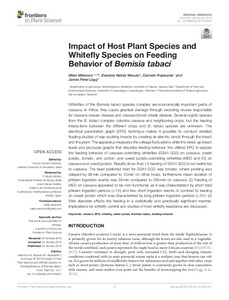| dc.contributor.author | Milenovic, M. |
| dc.contributor.author | Wosula, E.N. |
| dc.contributor.author | Rapisarda, C. |
| dc.contributor.author | Legg, J. |
| dc.date.accessioned | 2019-12-04T11:33:54Z |
| dc.date.available | 2019-12-04T11:33:54Z |
| dc.date.issued | 2019-01-22 |
| dc.identifier.citation | Milenovic, M., Wosula, E.N., Rapisarda, C. & Legg, J. (2019). Impact of host plant species and whitefly species on feeding behavior of Bemisia tabaci. Frontiers in Plant Science, 10(1), 1-14. |
| dc.identifier.issn | 1664-462X |
| dc.identifier.uri | https://hdl.handle.net/20.500.12478/5842 |
| dc.description | Open Access Journal |
| dc.description.abstract | Whiteflies of the Bemisia tabaci species complex are economically important pests of cassava. In Africa, they cause greatest damage through vectoring viruses responsible for cassava mosaic disease and cassava brown streak disease. Several cryptic species from the B. tabaci complex colonize cassava and neighboring crops, but the feeding interactions between the different crops and B. tabaci species are unknown. The electrical penetration graph (EPG) technique makes it possible to conduct detailed feeding studies of sap-sucking insects by creating an electric circuit through the insect and the plant. The apparatus measures the voltage fluctuations while the wired-up insect feeds and produces graphs that describe feeding behavior. We utilized EPG to explore the feeding behavior of cassava-colonizing whiteflies (SSA1-SG3) on cassava, sweet potato, tomato, and cotton; and sweet potato-colonizing whiteflies (MED and IO) on cassava and sweet potato. Results show that: (1) feeding of SSA1-SG3 is not restricted to cassava. The least preferred host for SSA1-SG3 was tomato, where probing was delayed by 99 min compared to 10 min on other hosts, furthermore mean duration of phloem ingestion events was 36 min compared to 260 min on cassava. (2) Feeding of MED on cassava appeared to be non-functional, as it was characterized by short total phloem ingestion periods (<1 h) and few, short ingestion events, in contrast to feeding on sweet potato which was characterized by long phloem ingestion periods (>5 h). (3) Wire diameter affects the feeding in a statistically and practically significant manner. Implications for whitefly control and studies of host whitefly resistance are discussed. |
| dc.description.sponsorship | Erasmus Mundus EU project |
| dc.format.extent | 1-14 |
| dc.language.iso | en |
| dc.rights | CC-BY-4.0 |
| dc.subject | Cassava |
| dc.subject | Sweet Potatoes |
| dc.subject | Bemisia Tabaci |
| dc.subject | Feeding Habits |
| dc.subject | Whiteflies |
| dc.title | Impact of host plant species and whitefly species on feeding behavior of Bemisia tabaci |
| dc.type | Journal Article |
| dc.description.version | Peer Review |
| cg.contributor.crp | Roots, Tubers and Bananas |
| cg.contributor.affiliation | University of Catania |
| cg.contributor.affiliation | International Institute of Tropical Agriculture |
| cg.coverage.region | Africa |
| cg.coverage.region | East Africa |
| cg.coverage.country | Tanzania |
| cg.creator.identifier | EVERLYNE WOSULA: 0000-0001-5693-0889 |
| cg.creator.identifier | James Legg: 0000-0003-4140-3757 |
| cg.researchtheme | PLANT PRODUCTION & HEALTH |
| cg.isijournal | ISI Journal |
| cg.authorship.types | CGIAR and advanced research institute |
| cg.iitasubject | Pests Of Plants |
| cg.iitasubject | Plant Health |
| cg.iitasubject | Plant Production |
| cg.journal | Frontiers in Plant Science |
| cg.howpublished | Formally Published |
| cg.accessibilitystatus | Open Access |
| local.dspaceid | 105399 |
| cg.targetaudience | Scientists |
| cg.identifier.doi | https://dx.doi.org/10.3389/fpls.2019.00001 |

